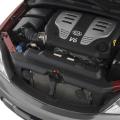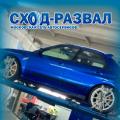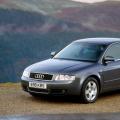Dynamics, handling, prestige and the word "BMW" have long been synonymous. However, for everything someday comes the reckoning. What will have to sacrifice in case of purchasing a supported BMW five in the back of E60 / E61 (2003-2009)?
Due to the fact that Chris Bangle worked on the design of the E60 body (and not only), the "five" was not immediately accepted by the public.
After the strict and fanciful BMW 5th series in the back of the E39, which many considered, and still consider, the best "five" in terms of design, the E60 seemed too "colorful" and catchy. As a result, supporters and opponents were divided into two hostile camps, where each has its own truth. It only remains to add that over time, the E60 began to be perceived less emotionally, and nowadays this body does not look outdated even today and attracts attention on the road.
So, a year after the debut of the E60, a station wagon appeared in the sedan body, the series of which was E61. - each motorist will determine for himself.
The line of gasoline power plants was as follows: 2.2 L (170 horsepower), 2.5 L (192 horse power), 3 L (231 horse power), and the most powerful 4.4 L V8 (333 horse power). The power range of smaller turbodiesels is a six-cylinder 3-liter with a capacity of 218 horsepower and a four-cylinder turbodiesel engine developing 163 horsepower, which appeared in 2005. In the same year, the "six" with a volume of 2.5 liters and a capacity of 177 horsepower became the basic power plant. It is worth noting that the power of the 2.5 and 3 liter engines has increased. In the course of restyling, which was carried out in 2007, the range of power units was replenished with a four-cylinder two-liter engine with a capacity of 170 horsepower.

After 100,000 kilometers, exhaust gas catalysts can "live long" - they simply bake and fall apart. with platinum electrodes it is usually enough for 30,000 - 40,000 kilometers, adjusted for our harsh operating conditions, because in Europe they serve up to 100,000 kilometers, or even more.
The bearings of the cooled generators are also not the strong point of this car - they serve an average of 50,000 kilometers and are changed only as an assembly. It is also recommended, from time to time, to clean the injection system, but there is no need to remove the injectors from the engine.
Gearboxes
No particular problems were noticed, however, diagnostics, nevertheless, will not hurt. The clutch serves up to 150,000 kilometers, under the condition of normal operation, it will last 3 times less for "racers". It is recommended to change the oil in the boxes every 60,000 kilometers.

BMW suspension
The weak point is the steering rack, which, as a rule, "does not go" more than 100,000 kilometers. Ball joints and silent blocks of the rear arms of the BMW 5-series E60 urgently requires special attention, taking into account the quality of Russian roads. Therefore, it is worth doing it more often, especially if you have a garage with a pit.

Outcome
BMW 5 Series E60 is capable of delivering a lot of driving pleasure, but you have to pay for the pleasure. Think again before deciding to buy this vehicle from the aftermarket. Be sure to go through the diagnostics and check the "history" of the car, as the car thieves did not deprive the E60 of attention. Good luck!
The fifth series of BMW cars has been produced since 1972, and the first cars are completely different from modern cars - the German concern has never stood still and constantly used the latest technologies.
There is no limit to perfection
Each subsequent model became more and more perfect and popular, and the sixth generation of BMW "five" became almost a legend.
The BMW E60 passenger car was produced from 2003 to 2010, and it was very noticeably different from its classmates with its rich equipment and electronic equipment.
Even cars of recent years can envy the "five" - \u200b\u200bmany modern foreign cars of the latest years of production do not have such a large number of options.
In 2005, the Bavarian company introduced the BMW E60 to the world in the M5 version, which was equipped with a new 10-cylinder S85 power unit with a capacity of 507 hp. from.
In this configuration, "Beha" is just fire - the car accelerates to "hundreds" in 4.7 seconds.
BMW E60 / E61 was produced in sedan and station wagon bodies, restyled in 2007:
- installed new optics;
- bumpers were replaced;
- fog lights have become different;
- minor changes have affected the interior of the car.
Features of the BMW E60
The predecessor to the 60 series was the E39, and compared to the previous version, the new brand has a revolutionary change.
In particular, this applies to the body - so that the front and rear axles are in the same weight ratio, aluminum body elements were installed in the front of the car:
- front;
- hood;
- front fenders.
The front suspension also has a lot of aluminum parts, although aluminum arms and a beam have already been used on the E39.
Another innovative solution of the German concern is the introduction of an electronic iDrive system into the car, which controls all the electronic components of the car.
Of course, the innovation made the control convenient, but also added a lot of troubles for car owners - if the electronics fail, it is very difficult to understand it.
BMW E60 specifications
The equipment level of the BMW E60 has become significantly higher than that of the E39, and the new car has also turned out to be more comfortable and safe.
"Five" BMW in the sixth generation has the following technical characteristics:
- dimensions - 4.84 / 1.85 / 1.47 m (length / width / height);
- distance between axles (wheelbase) - 2.89 m;
- front / rear wheel track - 1.56 / 1.58 m;
- the number of people in the cabin - 5 (including the driver);
- car weight (equipped) - 1.49 tons;
- gross vehicle weight (five passengers + luggage) - 2.05 tons;
- fuel tank capacity - 70 l;
- trunk volume - 520 liters.
E60 cars were produced in both front-wheel drive and all-wheel drive versions, all-wheel drive were equipped with BMWs with 2.5 and 3.0 liter internal combustion engines.
Engine
BMW E60 engines are installed in various types, and if all types of fuel systems are taken into account, there will be a total of 19 modifications.
It is easier to distinguish between motors by volume.
Gasoline:
- 2000 cm 3 (170 HP in two modifications);
- 2300 cm 3 (177/190 HP);
- 2500 cm 3 (192/218 HP);
- 3000 cm 3 (231/258/272 HP);
- 4000 cm 3 (306 hp);
- 4500 cm 3 (333 hp);
- 5000 cm 3 (507 hp);
- 5500 cm 3 (367 HP).
Also, various volumes of diesel engines were installed on BMW:
- 2000 cm 3 (163/177 hp);
- 2500 cm 3 (170/197 hp);
- 3000 cm 3 (235 HP);
- 3500 cm 3 (286 HP).
The engines themselves are quite reliable, but they require careful operation; it is also necessary to use only high-quality fuel and engine oil.
Like all other engines, BMW power units do not tolerate overheating, and in 2.5 and 3.0-liter N52 internal combustion engines, the cylinder block can fail from high temperatures.
Still all BMW engines sin by the fact that they "eat up" the oil a little - but this is not scary, the main thing is to monitor the oil level in the crankcase.
If the flow rate begins to approach the 1l / 1000 km mark, then you should already contact a car service.
On N52B30 engines, after 70-80 thousand km they can knock, the problem is eliminated by replacing them.
This phenomenon was observed on motors until 2008, after the engine was modified, and the valves on it were already knocking extremely rarely.
Later, the N52 engine series was replaced by the N53 - the new engines became even more reliable.
Diesel engines are even more critical to the quality of fuel than gasoline ones, and "Behu" diesel fuel should be refueled only at "correct" gas stations.
First of all, the turbine breaks down from poor diesel fuel, problems can begin at the first hundred thousand kilometers.
Even on the motors, the ventilation system is often clogged, and if it clogs, oil begins to flow from all the cracks.
BMW diesel engines also have one very good quality - it is traditionally believed that a diesel engine does not start well in cold weather, but BMW engines break this "tradition", they start without any problems at ambient temperatures down to -300C.
Transmission
BMW E60 is equipped with two types of gearboxes:
- mechanical "six-steps";
- six-speed automatic machines.
The mechanical part of both transmission options is very reliable, but the electronic control system on the automatic transmission can malfunction.
The problem is eliminated by flashing the control unit - another program is installed, errors are erased from the computer's memory.
There have been heated debates about changing the oil in the automatic transmission for a long time - whether it is necessary to change it at all or not.
According to the factory conditions, the automatic gearbox does not need to change the oil at all for its entire service life, it is only required to top up if necessary.
Servicemen, however, claim that changing the oil in the automatic transmission will not hurt, but what needs to be "poured" into the transmission cannot really answer.
Many car owners have come to this opinion - if there are no problems with the box, nothing needs to be done with it.
Electrical part
Low-quality gasoline primarily affects not the mechanical part of the engine, but the electrics - various sensors fail:
- fuel pump;
- nozzles.
Also, the catalyst is clogged with soot and soot, and its replacement costs very decent money.
Many car owners, in order to save money, put a flame arrester and "snag", but it is better to install a new one.
Chassis
The suspension of the BMW E60 is very soft, it easily swallows any spots on the roads.
On the one hand, this is a plus, but on the other hand, and a minus, those who like to drive a car quickly kill the "hodovka", despite its survivability.
Traditionally, the stabilizer struts and the steering rack are considered weak on BMWs.
A new rail costs about $ 2,000, although you can buy a remanufactured mechanism or a used part at a car breakdown. It is difficult to say how much used rake "passes".

Inside the updated BMW E60 sedan, changes have been made to the center console and the iDrive system, which has received eight freely programmable buttons. The car has different front door panels with more convenient closing "handles". The glass and mirror adjustment buttons are integrated into the armrest. Innovations also include a redesigned selector lever and steering wheel paddle shifters. Added touch keys for the head unit. New finishing materials have increased the attractiveness of the interior. The standard equipment includes "fog lights", electric mirrors, leather multifunctional steering wheel, on-board computer, dual-zone climate control, electric driver's seat. Options include heated and memory seat settings, leather upholstery, navigation system and more.
On the Russian market, a number of modifications of the updated BMW 5-series began with the most inexpensive model 520d with a 163-horsepower 2.0-liter 4-cylinder diesel engine. The next position was occupied by the most popular gasoline models with six-cylinder engines: 525i and 530i. The first was equipped with a 3.0-liter unit with a capacity of 218 hp, and the second - with an increased to 272 hp. recoil. Another diesel modification 530d was also equipped with a six-cylinder engine - 3.0 liters and 235 hp. Top places in the list were taken by the 540i (4.0 l, 306 hp) and 550i (4.8 l, 367 hp) models with V-shaped "eights". The latter accelerates from zero to "hundreds" in just 5.2 seconds. The best result was achieved only by the sports "Emka" with a V10 engine (5.0, 507 hp) in combination with a 7-speed SMG gearbox - the M5 sedan accelerated to "hundreds" by half a second faster. All versions of the redesigned BMW 5 Series E60 were equipped with a range of BMW EfficientDynamics technologies as standard. These include braking energy recovery, active choke control and the connection or disconnection of auxiliary mechanisms, depending on the driving conditions. The "Shift Point Display" indicator, located between the speedometer and tachometer, shows the driver the best gear to save energy according to his driving style. The result is one of the best-in-class performance-to-performance ratio.
The fifth generation BMW 5-Series has a fully independent aluminum suspension. Front - with MacPherson struts. The rear multi-link, sophisticated and technically advanced, provides a high degree of stability. Rear air suspension was installed on request. The optional Dynamic Drive active suspension with hydraulic actuators for the active anti-roll bars ensures a smooth ride in comfort mode and prevents body roll in sport mode. All wheel disc brakes (front ventilated), steering - with hydraulic booster. An optional active steering system was offered, which adjusts the steering angle in proportion to the vehicle speed. For some modifications, the xDrive all-wheel drive system was offered - based on an electromagnetic clutch, which flexibly distributes traction between the axles. Dimensions of the E60 sedan: length 4841 mm, width 1846 mm, height 1468 mm. Wheelbase 2888 mm. Turning circle 11.4 m. Vehicle weight is 1545-1735 kg. Trunk volume 520 liters.
The safety of the updated BMW E60 models since 2007 is determined by the presence of tensioning belts and six airbags. For active safety, the ABS system is responsible, supplemented by an emergency braking assistance system and brake force distribution. The car was also equipped as standard with Dynamic Stability Control and Dynamic Traction Control. The list of additional options includes a new system of adaptive cruise control "Stop & Go", designed to maintain speed during monotonous driving in long traffic jams up to a complete stop and acceleration. New features also include lane departure warning, head-up display and night vision.
The advantages of the BMW 5-Series E60 sedan are handling, dynamics, comfort. Sporting qualities are not in question, but the chassis requires increased attention. The aluminum front is a plus in terms of no corrosion, but a minus for repairs. After the restyling, the problem with the gas ventilation valve and other "diseases" were eliminated, but there remained an increased oil consumption, a capricious "automatic machine". The car is demanding for qualified service, especially in terms of electrical engineering.
BMW E60 is a car with an extraordinary appearance, stuffed with advanced technologies for those times. In 2003, the BMW 5 Series in the back of the E60 became a revolutionary car in the class. And how this affected the reliability of the car and whether it makes sense to buy a car in this body on the secondary market now we will figure it out.
The E60 is the most popular 5 in BMW history, because the largest number of these cars was produced. In terms of driving performance, it is significantly better than its predecessors. Excellent handling without sacrificing ride smoothness, perfect axle weight distribution. The car is equipped with the highest category: 6 airbags, dynamic stabilization system, climate control, alloy wheels.
In the secondary market, the simplest options equipped with 156-horsepower 4-cylinder engines are very rare. Mostly there are cars with engines of 2.5 and 3 liters.
You can find cars with all-wheel drive and station wagons. Rust on the body is rare, but it can be found on the cheapest examples. But in general, the body metal is excellent at resisting corrosion. Also, the owners of 5-k BMW are wealthy people who do not save on quality service. Nevertheless, squeaks and clicks in the front panel area may appear over time. And all because the body of the 5th series is made using a special technology - the front rails of the struts are made of aluminum and riveted to a steel frame for proper weight distribution of the car.
Such a structure must be rigid and as strong as possible. But there were often cases, especially after driving on bad roads, that these connections were no longer strong. Such a defect was eliminated under warranty. But in the event of a serious accident with damage to the power elements, you will have to take the car to a company service.
Also, if there are problems with electronics, then artisanal craftsmen will not help here either. Although the BMW 5 has a lot of problems with electronics. The most common problems in electronics are glitches in the iDrive system. Basically, it is a computer that controls almost every function in the car, from adjusting the stiffness of the shock absorbers to adjusting the brightness of the interior lighting. If at least one of the sensors fails, this, in most cases, leads to the failure of the entire system. BMW engineers are constantly improving the electronics, so the service recommends updating the iDrive every six months. And such an operation costs 5,000 rubles. And if the processor fails, you will have to change the entire computer, which will cost you 50,000 rubles.
The suspension here is aluminum, thanks to which it was possible to achieve excellent handling. And it is quite reliable, the rear multi-link is especially good, its parts can easily last up to 100,000 km. But there are also weak points, for example, the stabilizer struts - they serve 20-30 thousand km. Even the steering rack can start tapping after a year of operation, but it should only be changed if fluid begins to flow, which is quite rare. But the hydraulic actuators of active stabilizers flow very often, and they cost serious money - about 50,000 rubles. Therefore, you need to buy a car on a conventional suspension, without the Dynamic Drive system, even on shock absorbers with it, you can save money. The front and rear pads run on average 25-30 thousand km.
The brake discs will last about 60,000 km. A car in this body was produced for only 8 years, and during this time 20 different engines were installed in it. Some motors were discontinued in 2005 and are not found on later versions. But the most problem-free engines are considered to be gasoline 2.5-liter and 3-liter 6-cylinder engines, and 2.2-liter engines with a capacity of 170 hp. from.
After 2007, the N53 series direct injection engines appeared, which were installed in the 523i, 525i and 530i. But these motors still eat oil - about 1 liter of oil per 3000 km. And you can control the oil level only by the indicator on the instrument panel, since there is usually no dipstick in motors. And if the light comes on, it means that it is time to add a whole liter of oil. Also after 12,000 km. a light comes on that it is time to change the oil, but mechanics recommend making a replacement after 10,000 km. mileage.
It is also necessary to clean the radiator of the cooling system from dust and dirt once a year. But this does not prevent leaks. It happens that the radiator starts to leak after a year of operation.
It goes without saying that you need to refuel only with high-quality fuel, because the fuel pump and candles may fail prematurely. But even if you fill up with high-quality fuel, the catalysts still fail after 100,000 km. mileage. And it is necessary to make a replacement as soon as possible, because crumbs from destroyed honeycombs can get into the cylinders and then the engine will end.
Diesel engines are quite reliable and the car starts well in winter. But the weak point is the turbine, which serves no more than 100,000 km. Better to avoid a car with a 4-cylinder engine, this is the restyled 520i model. He often has a loss of thrust and difficulty when starting in cold weather.
Transmission
The gearboxes that are installed in BMW are quite reliable. Mechanical boxes do not break at all, but as a rule, a car with a mechanics cannot be found in the secondary market. And in a 6-speed automatic, sometimes jolts may appear during switching, and all due to malfunctions in the control unit. But if you reflash it, then the problems can go away. Sometimes a plastic gearbox sump is required, due to severe overheating it can lead to oil leakage.
All-wheel drive versions are quite reliable and there is no reason to immediately abandon them. There are usually no malfunctions with the electro-magnetic clutch of mechanics. If you really like the BMW M5 in the back of the E60, and you can now buy it for relatively little money, you must remember that the clutch in this car is a consumable. The disc and the basket live no more than 30,000 km. It also requires replacement of the 2-mass flywheel of the engine. And for those who want to save money on expensive service, one must remember that the E60 is not the car on which it makes sense to save.
Body repairs and work with electronics can only be done by specialists from official service stations, and their work costs a lot of money. As practice shows, the resource of parts for this car does not exceed 100,000 km. Or about 2 years. That is, after the end of the warranty period, the car begins to gradually crumble.




